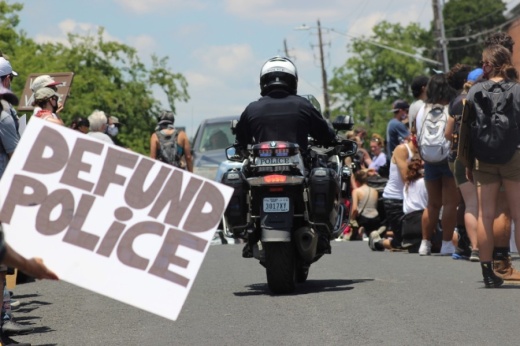However, with only two weeks until City Council has to vote on City Manager Spencer Cronk’s proposed fiscal year 2020-21 budget, which offers a less than $200,000 year-over-year reduction in dollars spent on policing, officials said much of the transformational change promised will happen after budget adoption.
Cronk has called his proposal, which he released July 13, a “snapshot” budget. Widespread calls for radical changes in policing began just over a month before he published his draft budget—an almost yearlong process. City Council will vote on the budget between Aug. 12-14. Cronk and City Council members said, given the tight timeline, they expect the most significant changes to policing and the police budget to happen after the budget is approved through post-adoption amendments.
District 6 City Council Member Jimmy Flannigan, who heads the City Council’s Public Safety Committee, said the public will see some changes ahead of Aug. 12. But he said he sees major shifts in police funds and responsibilities taking longer. However, he expects City Council to make specific commitments for which the public should hold them accountable.
“I expect City Council to adopt a fairly comprehensive set of budget directions at the same time we take the legally required, formal step of adoption,” Flannigan said. “We’ll have to be definitive with the public that these are the thing we’re going to do.”
Sweeping proposals already made
Three City Council members have already proposed specific and significant changes to the police budget and operations.
District 7 City Council Member Leslie Pool offered a combination of budget cuts and structural changes that come out to a $103.7 million reduction in the police budget. She threw her support behind budget cuts proposed by Just Liberty, a local criminal justice reform organization. The group’s proposal calls for $41.5 million in police budget cuts ranging from a $23 million slash in eliminating vacant positions and cutting the overtime budget by $10 million to shutting down the police academy in 2021.
Pool went further, proposing an additional $3.2 million in cuts and a restructuring of responsibilities that would shift another $59 million out of the police department. This includes, among other changes, moving the forensics lab, police communication system, internal affairs department and victim services out from under the command of the department—totaling $36.5 million.
City Council Member Greg Casar has proposed his own $37.5 million shift, which also includes moving internal affairs and the forensics lab to outside of the purview of the Austin Police Department. Casar has also proposed canceling all cadet classes through the next two years and shifting that funding into other forms of public safety, a cost-savings measure he calculates at $20 million.
There is growing momentum around canceling the cadet class scheduled for November since a full review of the police academy’s training materials will not be complete until then. However, most City Council members have not offered full-throated support for canceling cadet classes for the next two years.
Flannigan's “reconstruct and deconstruct” plan proposes a complete reconfiguring of the local police governance structure, essentially dismantling the Austin Police Department as it is known today and dividing duties up into five separate departments: emergency communications and technology, patrol, investigations, professional standards and traffic safety. Each department would have its own, independent department head. The proposal would eliminate some executive police positions and shift many sworn positions into civilian roles.
Flannigan also put forth a plan to move police operations out of the downtown headquarters building and place officers in currently underused buildings. The city would then demolish the headquarters building—a proposal that has long been on the table—and consider a community use for the valuable property, which sits near the city’s Waterloo Greenway project and along the section of I-35 that is proposed to get buried underground through a state reconstruction project.
The sliding scale of time and trust
Transformational changes in government structure are often slow moving, but City Council is pushing to pick up the pace. Deputy City Manager Nuria Rivera-Vandermyde laid out the wide scope of work being examined by Cronk’s task force on reimagining policing. The “conceptual framework” laid out four categories of work with 26 subcategories, ranging from community outreach plans to an examination of police department governance structure. Rivera-Vandermyde said several reports are in progress, and unanswered questions remained.
Austin Mayor Steve Adler said the staff’s report was thorough, but City Council and the community needed to see more to prove this task force is different from other, traditionally slow-moving task forces. Adler said, on its face, there was nothing to suggest this was any different.
“The process has to manifest, on its face, the direct assurance that this is open, transparent and as fast as change as possible,” Adler said.
City Council members echoed the mayor’s comments, saying too slow a process could result in a deterioration of trust. Council members pushed staff to create a calendar to bring to the community hard and fast deadlines for this work to be completed. Casar said the city has to find a way to bridge the gap between the community’s demands, the City Council’s requests and the staff’s work.





